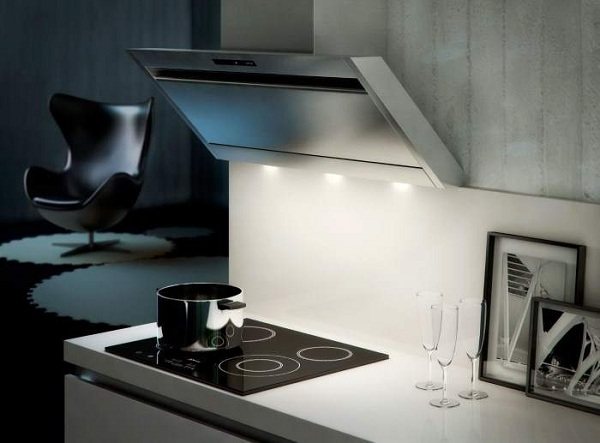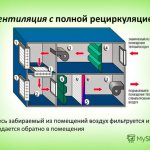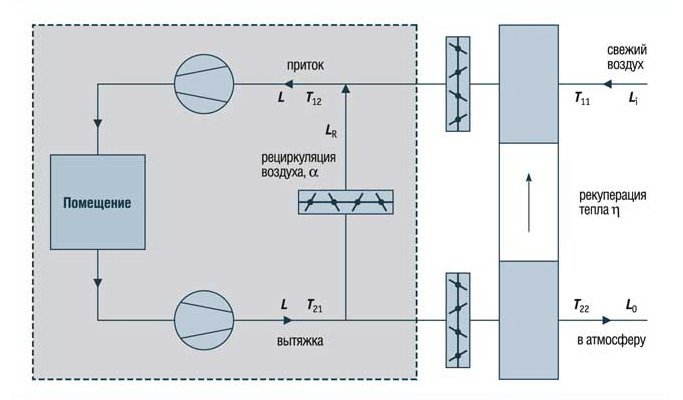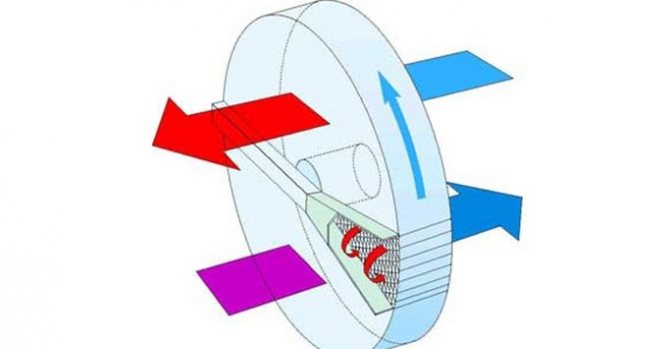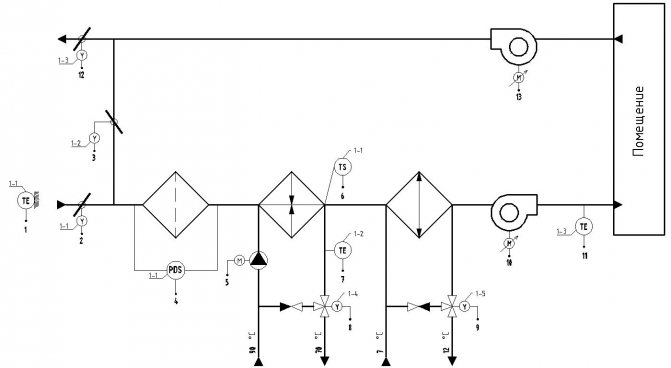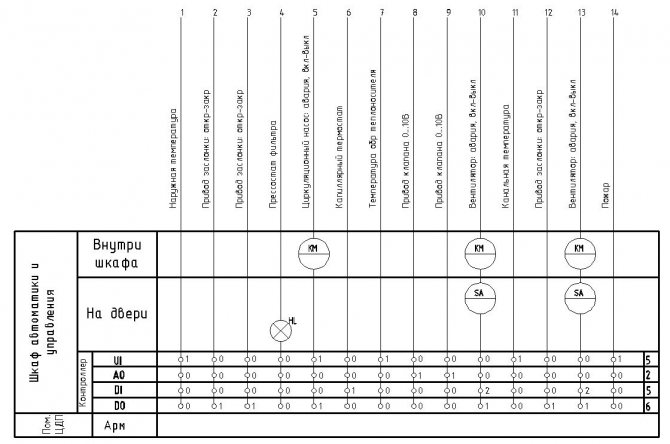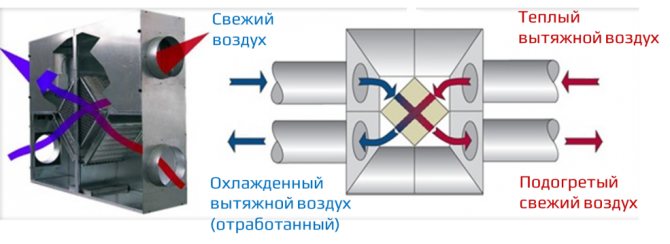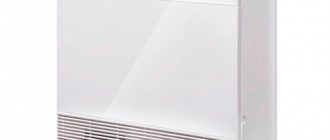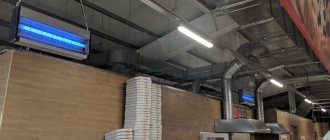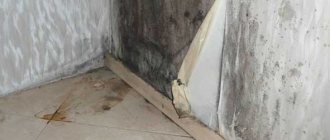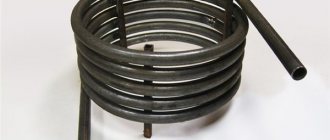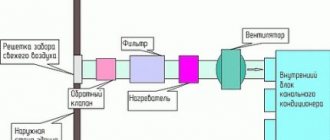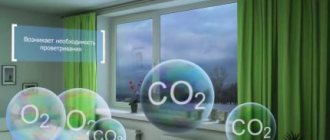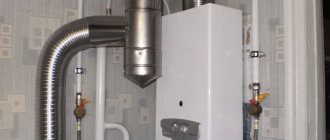Fast passage:
- Plus system
- Disadvantages of the system
- SNiP
How do I get a commercial offer?
Prom Klimat is a professional design and installation company. We implement engineering systems of a building or premises at your facility on a turnkey basis. Send your applications by email or call by phone, and our engineer will prepare you our commercial offer.
Recirculation of air is mixing room air with outside air and supplying this mixture to this or other rooms. Recirculation is not the mixing of air within the same room, including that accompanied by heating (cooling) by heating units (devices) or fans - fans.
Recirculated air ventilation is a system where part of the air taken from the room is mixed with cold outside air, heats it to the required temperature and then delivers it into the room. Moreover, this system can be used only if the air coming from the room does not contain harmful substances and toxic impurities. Whereas the volume of outside air in this mixture must comply with all sanitary and hygienic standards specified in SNiP, and must not be less than the value of the sanitary standard provided for this type of room.
Recirculated air ventilation is widely used in general ventilation systems in buildings.
Principles of ventilation with recirculation
The general scheme of operation of the supply and ventilation system with recirculation is as follows: through the inflow, street air is supplied to the room, which after a while is drawn into the exhaust system. Part of it is irretrievably thrown out into the street, and part goes into the mixing chamber. There, the air mixes with the fresh inflow, cooling or heating it (depending on the type and settings of the system), then it enters the air heater or air conditioner, from which it enters the room through the ventilation pipes. The main purpose of recirculation is to reduce the load on air handling systems (heaters, air conditioners, etc.).
To keep the air in the room fresh and breathable, when using recirculation in the ventilation system, the following conditions must be observed:
- The volume of clean air supplied from the outside must be at least 10% of the capacity of the air handling unit;
- The air entering the room must contain a maximum of 30% of harmful substances from their maximum permissible concentration.
General classification of ventilation systems
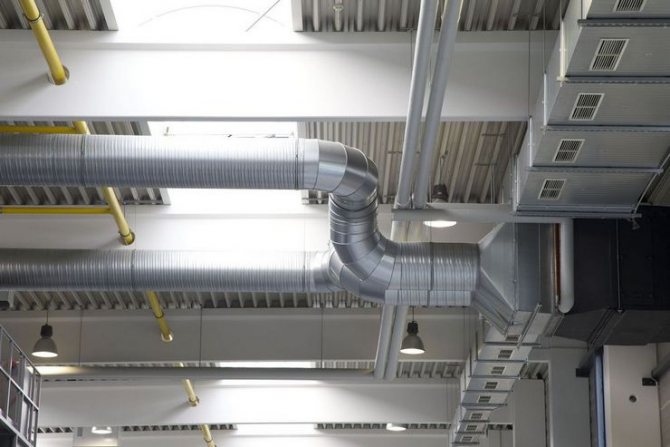
The types of ventilation systems can be classified according to 4 criteria:
- Depending on the way the air is circulated;
- Depending on its purpose;
- Depending on the structural structure;
- Depending on her working area;
Each of them has advantages and disadvantages.
Types of ventilation by the method of forming air flows
Natural ventilation - the air in the room is renewed due to the presence of natural draft, the presence of which is determined by one of two factors:
- Temperature difference indoors and outdoors;
- The pressure difference between the room and the exhaust.
The presence of traction is also influenced by various atmospheric phenomena, for example, the presence of wind. Such ventilation is simple enough to complete, consumes a small amount of electricity and is easy to use.
The ventilation system, operating due to the mechanical work of its components, is capable of covering much larger rooms, but it is more expensive in terms of electricity consumption due to its autonomy.
Ventilation classification by purpose


Depending on its purpose, the ventilation system is divided into:
- Supply air - works by bringing in fresh air;
- Exhaust - works for the outflow of air that has already been exhausted.
In practice, both of these systems are used together.
In addition to this classification, there are also:
- Local ventilation - providing air circulation in a specific area;
- General ventilation - for air circulation in large rooms.
Types of ventilation systems by area of operation
The local ventilation system is classified into supply and exhaust. During its operation, air is supplied to a certain area and only the place where carbon dioxide accumulates - the ceiling of the room is cleaned. An example of local ventilation is an air curtain, which is often used in public spaces.
A local ventilation system is the best option for air purification in places where there is an increased accumulation of contaminants. It makes it possible to avoid their spread throughout all rooms and significantly reduces the load on the ventilation system of the building as a whole.
Ventilation with recirculation and heating.
Cold outside air is mixed with warm air taken from the room, heated to the required temperature, and then supplied to the room
- fans on
- outdoor and extract air dampers open
- the heater is working
- supply and extract fans on
- dampers for outdoor, extract, recirculated air are open, each depending on the set amount of outdoor air
- the heater is working
Circulation options
An air conditioner is a modern option that not only guarantees cooler temperatures, but also creates a healthy and sterile environment. Depending on its installation, the cooling system can be either in the center of the house or on the wall. While the former is effective for the entire home, the latter is designed to cool one room or just a small area.
In hot and humid countries, air conditioning is no longer considered a luxury, but a public domain. The growing demand has prompted the industry's decision to significantly expand the production of air conditioners. The search for more energy efficient models that use safe refrigerants is ongoing.
Another way of air recirculation system is the use of heat pumps. These types of models of spatial objects of heating, as well as cooling systems within the same block. During the summer, the heat pump works as an air conditioner, which can significantly reduce the temperature and humidity inside the structure, and it can also deliver heating during the winter months. As content from the outside continuously flows into the dwelling, the recirculation of air changes frequently, and the overall quality of being in the room improves.
Recirculated ventilation without heating
During the transition period, when the outside temperature rises and the indoor heating system is operating, the task of the supply ventilation system is reduced only to supplying fresh air. In this case, additional heating of the air after recirculation can be dispensed with.
- fans on
- the recirculated air valve opens proportionally to the requirements for the supply air temperature
- the outdoor air damper closes in proportion to the supply air temperature requirement
- the heater does not work
- supply and extract fans on
- outdoor, extract and recirculated air dampers are open - depending on the requirements for the supply air temperature
- the heater does not work
The use of air recirculation in ventilation systems is allowed only during cold and transitional periods of the year (for air conditioning units at any time of the year). In this case, outside air must be supplied to the room in an amount not less than the above.
Ventilation systems with and recirculation of heat
Air recirculation in ventilation systems is the mixing of a certain amount of exhaust (exhaust) air to the supply air. Thanks to this, a reduction in energy consumption for heating fresh air in the winter season is achieved.
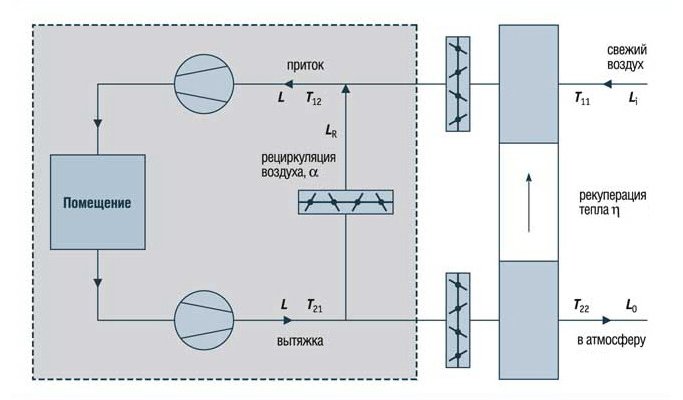

Supply and exhaust ventilation with recuperation and recirculation, where L is the air flow, T is the temperature.
Heat recovery in ventilation Is a method of transferring heat energy from the exhaust air stream to the supply air stream. Heat recovery is used when there is a temperature difference between the extract air and the supply air, in order to increase the fresh air temperature. This process does not imply mixing of air streams; the process of heat transfer takes place through any material.


Temperature and air movement in the recuperator
Devices that recuperate heat are called heat recuperators. They are of two types:
Heat exchangers-recuperators - they transfer heat flow through the wall. They are most often found in supply and exhaust ventilation systems.
Regenerative recuperators - in the first cycle, which are heated from the outgoing air, in the second they are cooled, giving off heat to the supply air.
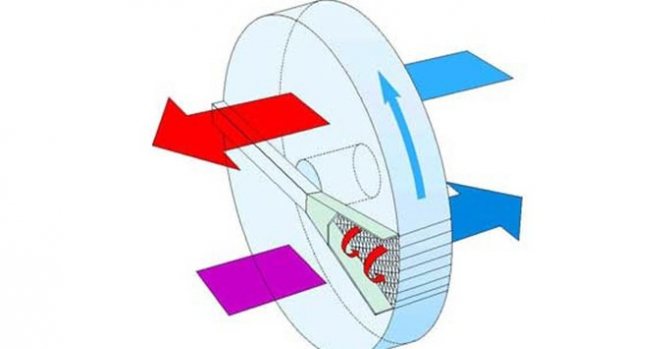

Heat recovery ventilation is the most common way to use heat recovery. The main element of this system is the air handling unit, which includes a recuperator. The device of the air supply unit with a recuperator allows transferring up to 80-90% of the heat to the heated air, which significantly reduces the power of the heater, in which the supply air is heated, in the event of a lack of heat flow from the recuperator.
Recirculation of air is not allowed:
- from rooms in the air of which there are pathogenic bacteria and fungi in concentrations exceeding those established by the State Sanitary and Epidemiological Supervision of Russia, or pronounced unpleasant odors
- from premises in which the maximum consumption of outdoor water is determined by the mass of the emitted harmful substances of the 1st and 2nd hazard classes
- from rooms in which there are harmful substances sublimated upon contact with heated surfaces of air heaters, if air purification is not provided in front of the air heater
- from rooms of categories A and B (except for air and air-thermal curtains at the outer gates and doors)
- from 5-meter zones around equipment located in rooms of categories B1-B4, D and E, if explosive mixtures of combustible gases, vapors, aerosols with air can form in these zones
- from laboratory premises for research and production purposes, in which work can be carried out with harmful or flammable gases, vapors and aerosols
- from systems of local suction of harmful substances and explosive mixtures with air
- from vestibule sluices
Classification of local air heating systems
Local air heating systems, in turn, are: ducted and channelless.
1.
Channelless local air heating systems A local air heating system designed to heat one single room. It is imperative to have a fan that constantly circulates or recirculates air in the room. An example of such a system is a conventional household fan heater. 2. Ducted local air heating systems This is a local air heating system designed to heat one single room. But a fan in such a system may be absent. But there is always a channel through which heated air enters the room due to natural circulation (convection), for example, from the bottom up.Fanless duct air heating system is simpler and cheaper, but at the same time less efficient system than air heating with a fan.
By way of air circulation in the system local air heating systems are of the following types:
Local air heating system with full recirculation In this system, only air from the heated room is used for heating, there is no addition of outside air. Those. no ventilation of the room. Again, a conventional fan heater can be cited as an example of a fully recirculated local air heating system. Ducted local air heating systems from item 2 are at the same time systems with full recirculation.


Local air heating system with partial recirculation With partial recirculation, part of the heating air enters the heater from the outside - i.e. the local air heating system simultaneously performs the functions of the room ventilation system. At the same time, the air in the room will be not only warm, but also fresh.


Direct-flow local air heating system In this system, all the air is supplied to the heater from the street, heats up and, with the help of a fan, enters the room or premises, and then is thrown back into the street. A very costly option of the system, since a very powerful heater is required to constantly warm up large volumes of air, which is usually not used in private country houses. But for public or industrial premises with stringent ventilation requirements (for example, if the production area emits vapors of harmful substances and you need to constantly remove them), it may be the only way to make air heating.


The main flow diagram for supply and exhaust ventilation with air recirculation
Most often, for the organization of supply and exhaust ventilation with recirculation, a scheme is used based on the use of a bundle of a fan coil and a chiller. The fan coil unit replaces the indoor unit of the air conditioner, working with an active battery. This is a prefabricated unit, in which there is a drain for organizing the outflow of condensate formed in the summer, a fan, a heat exchanger and an air filter. Chiller is a water heater, which, depending on the season, heats or cools water, then transfers its temperature to the incoming air.
The coolant temperature in the chiller is controlled from the control panel. This system allows full or partial air heating in winter and air conditioning in summer. The volume of the premises does not matter, as there are systems designed specifically for supermarkets and other large buildings. The advantage of this system is the ability to ventilate a large number of rooms in one building in a single climate mode. The fan coil air intake and exhaust points are routed using standard ventilation ducts.
As for the recirculation control, it is carried out using remotely adjustable dampers or grilles, which are controlled from the remote control. The temperature of the supply air differs depending on the season, while the temperature of the supply air supplied to the room should be comfortable. Its required value is set on the control panel. The chiller heats or cools the outdoor air to a predetermined value, it enters the heat exchanger, mixing with the air returned from the room, as a result of which it leaves the supply diffuser at the optimum temperature.
The amount of air that must be taken from the room and mixed with the outside air depends on the set temperature parameters in the room. It is according to this criterion that the set position of the dampers is determined.The dampers themselves are mounted at the points of air intake from the room, as well as on the street air intake line. The dampers are controlled synchronously and carried out from the remote control. Its parameters are adjusted by specialists in each case individually.
Additional recirculation ventilation schemes
Indoor air recirculation with ceiling fan
Recirculation with a single ceiling fan and air ducts divorced within the same room is not intended to supply or change the volume of the outdoor air flow. Such schemes, devoid of a fan coil and connection to the outdoor air intake, are used in a number of types of premises (cafes, shops, office buildings) solely to increase the mobility of air in the working area.
Attention! This option cannot be called full-fledged recirculation, because with it, air is taken from one part of the room to another so that it does not stagnate.
Indoor air recirculation with fan coil unit
Recirculation according to this scheme is quite common. The fan coil unit has a heat exchanger for cooling or heating the air, and an industrial fan that moves it. In fact, this is a duct air conditioner, or rather its analogue. Such a system is mounted separately from the main supply and exhaust ventilation and works as follows: in some areas of the room, air is taken in, through the air ducts it is fed into the heat exchanger, where it is heated or cooled, after which it is sent to other areas of the room with another network of air ducts.
The use of this system can be considered rational in small and medium-sized rooms, where supply and exhaust ventilation is represented, for example, only by wall fans mounted in ventilation shafts. Here, the implementation of a full-fledged combined recirculation ventilation is difficult and impractical, and this approach will create an acceptable microclimate at minimal cost without the need for a complete rework of all ventilation.
Recirculation with a fan coil unit with outside air mixing
The basis here is the same system with a fan coil as in the previous case, with the only difference - it has the ability to take air from the street. The outdoor fence is manually or automatically controlled by a damper. Its use is justified mainly when effective supply and exhaust ventilation has already been installed in the room, which there is no desire or opportunity to modernize.
Such a system can be used for heating or cooling air in a room, as well as an auxiliary supply unit.
Recirculation with dampers
When using two motors, it is allowed to use both a supply and exhaust ventilation system, as well as full or partial ventilation with recirculation.
The temperature regime of the external air masses at different times of the year has different values and can vary over a fairly wide range, at the same time the temperature regime of the internal air masses should always be approximately at the same level, which is comfortable for residents or workers.
To create a comfortable temperature in the building during the winter period of the year, the heater acts on the recirculated air masses and heats them up to the set air temperature in the room and the temperature regime is equalized according to the predetermined parameters. Each equipment has its own thermal capacity, therefore the volume of the mixed purified air masses in different periods of the year can be a different ratio, it all depends on the control of the dampers.
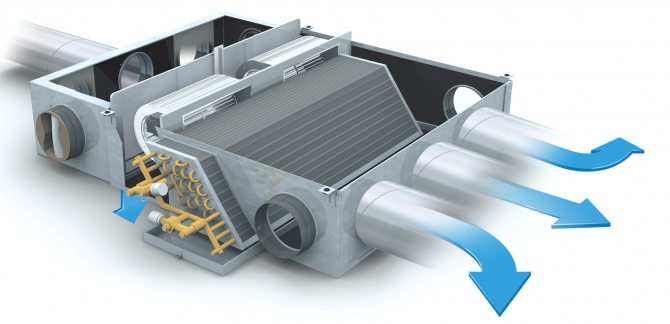

In the warm season, exactly the same process is carried out, but the cooling of the air masses is already carried out.The only point that must be taken into account is that in the warm season, the recirculated air masses have a lower temperature and the addition of purified air is carried out taking into account the capacity of the air conditioner.
When creating a recirculation system, the scheme of its installation and functioning should be developed only by specialists.
Advantages and disadvantages of the design
Installation of ventilation of this type does not differ from the standard placement of similar household appliances, but their autonomy is much higher. They are not tied to the ventilation system, so the designers have developed a number of compact pull-out hoods, where recirculation is used. They are called telescopic hoods. During operation, they filter by creating a strong lateral draft, sucking in all impurities along with the air flow. After shutdown, the system is recessed into the tabletop, which is very convenient and original.
Dignity
This type of device has slightly less performance and power, but this allowed manufacturers to reduce their cost, which only pleases users. All components of the systems experience less stress, so they can work without failures much longer.
With the operation of such a system, there is no place for reverse thrust. The stand-alone arrangement makes it possible to freely install the stove - users place it where it is most convenient for them, regardless of the location of the entrance to the ventilation shaft. Recirculating cooker hood Recirculating cooker hood in the kitchen interior
